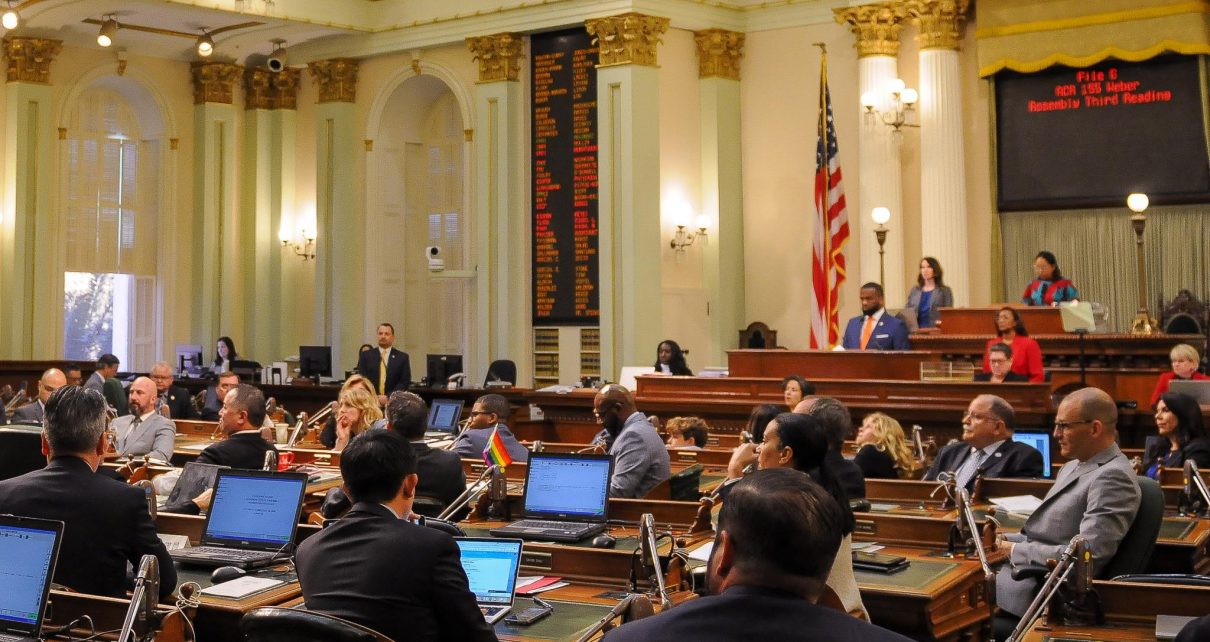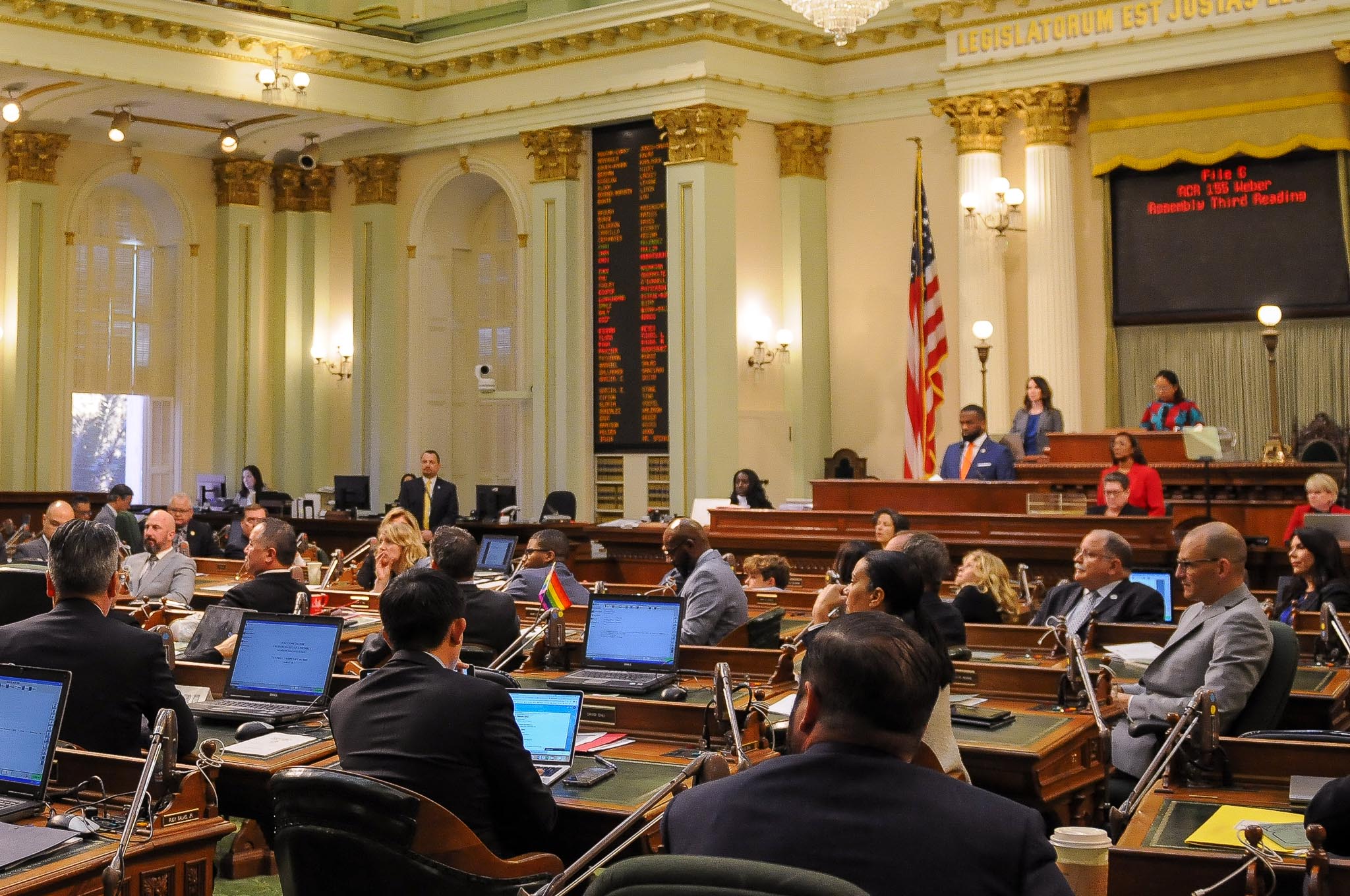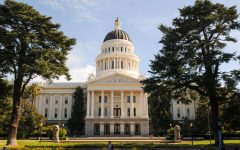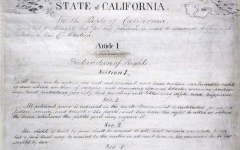
California State Assembly. (Photo: Kevin Sanders for California Globe)
Frequently Asked Questions about California Budget Terminology
What is Budget Year Plus One (or Plus Two)?
By Chris Micheli, May 28, 2024 7:18 pm
There are some common terms and phrases regarding the California Budget that readers should be familiar with, and which are defined by the Office of Legislative Counsel and the Department of Finance on their respective websites.
What are the A-Pages? This is the term often used to refer to the Governor’s Budget Summary, which are the Governor’s Budget highlights.
What is an Appropriation? An appropriation is an amount of money and authorization for a specific agency to make expenditures for a specified purpose.
What is the Appropriations Limit (“Gann Limit”)? The constitutional limitation on the maximum amount of tax proceeds that state or local governments may appropriate in a fiscal year. The limit is based on 1986-87 fiscal year appropriations, and is adjusted annually.
What are Authorized Positions? In the Salaries and Wages publication as part of the Budget, it is the past year’s total authorized positions in state government.
What is the Baseline Budget / Workload Budget? This is the “budget year cost of currently authorized services, adjusted for changes in enrollment, caseload, population, statutory cost-of-living adjustments, chaptered legislation, one-time expenditures, full-year costs of partial year programs, costs incurred pursuant to Constitutional requirements, federal mandates, court-ordered mandates, state employee merit salary adjustments, and state agency operating expense and equipment cost adjustments.”
What is a BCP (Budget Change Proposal)? This is an acronym for the term “Budget Change Proposal” which is a document prepared by a state agency and the Department of Finance to propose and document budget changes to maintain the existing level of service or to change the level of service, propose new program activities not currently authorized, or to eliminate existing programs.
What is the Blue Pencil? This is a term often used to refer to the Governor’s ability to line-item veto items of appropriation in the Budget Bill or appropriation bills (formally called the line-item veto).
What is the Budget? The state budget includes proposed expenditures of state moneys for the next fiscal year.
What is the Budget Act? This is the Budget Bill after it has been enacted into law.
What is the Budget Bill? This is the annual bill required by the constitution that sets forth the spending proposal for the next fiscal year, containing the budget submitted to the Legislature by the Governor.
What is the Budget Bill Junior? One or more bills that make adjustments to the annual Budget Bill (the plural is budget bills junior).
What is the Budget Year / Fiscal Year? The fiscal year addressed by a proposed budget, beginning July 1 and ending June 30. It is the 12-month period on which the state budget is planned. The federal fiscal year begins October 1 and ends September 30 of the following year.
What is Budget Year Plus One (or Plus Two)? This refers to the fiscal year following the upcoming fiscal year that begins, July 1. For example, the 2024-25 budget year begins July 1, 2024, while the Budget Year Plus One begins July 1, 2025.
What is a Capital Outlay? Generally, these are state expenditures to acquire or construct real property.
What is a Continuous Appropriation? This is a constitutional or statutory expenditure authorization that is renewed each year without further legislative action.
What are Control Sections? These are the sections of the Budget Act (e.g., 1.00 to the end of the Budget Bill) providing specific controls on the appropriations itemized in Section 2.00 of the Budget Act.
What is the Current Year Budget? A term used in budgeting to designate the operations of the present fiscal year in contrast to past or future periods, as well as the fiscal or budget year.
What is Debt Service? The amount of money required to pay interest on outstanding bonds and the principal of maturing bonds.
What is Early Action? A relatively new term to signify budget actions that occur prior to the normal June actions.
What is a Finance Letter? These are the revisions to the Budget Bill or current year expenditures that are proposed by the Department of Finance and addressed to the Legislature.
What is a Fund Balance? For budgeting purposes, this is the amount of the excess of a fund’s resources over its expenditures.
What is the General Fund (GF)? This is the state’s main account for revenues, primarily from the personal income tax, sales and use tax, and corporation taxes.
What is the Governor’s Budget Summary? This is a companion publication to the Governor’s Budget that outlines the Governor’s policies, goals, and objectives for the budget year.
What is the January 10 Budget? This refers to the Governor’s initial budget proposal, which is due per the Constitution by the tenth day of the calendar year.
What is the JLBC (Joint Legislative Budget Committee)? This is a joint committee with an equal number of Assembly Members and Senators. It is the duty of the committee to ascertain facts and make recommendations to the Legislature concerning the State Budget, the revenues and expenditures of the state, and the organization and functions of the state and its departments, subdivisions, and agencies, with a view to reducing the cost of the state government and securing greater efficiency and economy.
What is the Line-Item Veto? This is a term to refer to the Governor’s constitutional authority to line-item veto (i.e., reduce or eliminate) items of appropriation in budget or appropriation bills (also known as the “blue pencil”).
What is Local Assistance (LA)? These are expenditures made for the support of local government or other locally administered activities.
What is May Revise / May Budget Revision? The Governor is required to update his or her January budget proposal after the April tax receipts are available. Occurring no later than May 14, it is an updated estimate of revenues and expenditures that replaces the estimates contained in the Governor’s budget submitted in January.
What is a One-Time Cost? This is a proposed or actual expenditure that is non-recurring (usually only in one annual budget) and not permanently included in baseline expenditures.
What is a Reversion? This occurs with the return of the unused portion of an appropriation to the fund from which the appropriation was made.
What is a Schedule? The detail of an appropriation in the Budget Bill or Act that shows its distribution to each of the programs.
What are Special Funds? These are funds created by statute, or administratively per Government Code Section 13306, which are used to budget and account for taxes, licenses, and fees that are restricted by law for particular activities of the government.
What are the Summary Schedules? These are the various schedules in the Governor’s Budget Summary that summarize state revenues, expenditures, and other fiscal and personnel data for the past, current, and budget years.
What is a Trailer Bill? These are the bills that are required to enact statutory changes related to implementation of the budget.
- Statewide Child Support Registry - January 2, 2026
- Foreign Country Money Judgments - January 2, 2026
- How Many Bills Are on the Inactive Files? - January 1, 2026





Thanks for the great “vocabulary” lesson – critical to know how things work and what language we must share if we are to change or reform what has been happening in this state.
Might be time also for a recap of the entire history that led to Prop, 13 and the formation of the Howard Jarvis Taxpayer Associations. Where does this stand today?
When people forget what we did back then, its value can slip away. It was a huge tax payer revolution in this state, ironically now known only as a tax and spend liberal state of public union-endorsed Democrats. When and how did this radical shift take place?
Prop 13- the true voice of the people, deserves a study course for the generations who were not part of this taxpayer protection movement.
Why did Newsom play games with tax due dates last year – there was no “environmental emergency” to delay the tax due dates, until Oct/Nov instead of April 15 last year.
There must have been some political intent for that gimmick – avoid admitting the budget short fall and then claim we don’t yet know the full revenues yet?